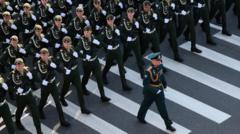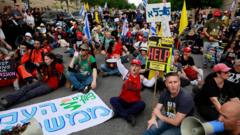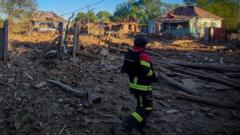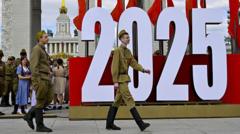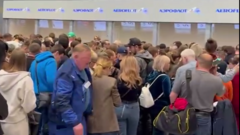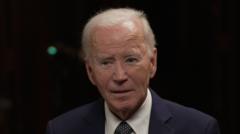The situation on the ground reflects a complex negotiation balancing various geopolitical interests and conflicting demands.
**US Steps Up Diplomatic Efforts to Resolve Ukraine Conflict Amid Uncertain Prospects**
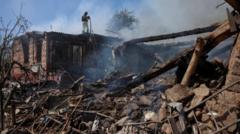
**US Steps Up Diplomatic Efforts to Resolve Ukraine Conflict Amid Uncertain Prospects**
Amid increasing diplomatic activity, the success of the US-led initiatives to end the Ukraine war remains in doubt.
The pace of diplomatic discussions aimed at resolving the ongoing conflict in Ukraine has accelerated in recent days. Meetings are being held in London between representatives from the UK, Germany, France, Ukraine, and the United States, while former President Donald Trump's special envoy, Steve Witkoff, is preparing for a fourth meeting with President Putin in Moscow. Despite these efforts, there remains significant uncertainty regarding the direction and effectiveness of these talks.
Previously, the American strategy for a ceasefire was straightforward: an unconditional 30-day ceasefire, followed by negotiations towards a permanent resolution. Ukraine demonstrated flexibility, agreeing to these terms under US pressure, waiving its demand for long-term security guarantees as a precondition for halt in hostilities. However, Russia rebuffed this proposition, insisting that a broader array of conditions must be met before any agreement could be reached. President Putin emphasized addressing what he sees as "root causes" of the conflict, specifically his apprehensions about NATO's expansion and Ukraine's sovereignty posing a threat to Russian security.
Currently, whispers about a potential US ceasefire proposal indicate a compromise might be taking shape. The suggested framework includes Russia agreeing to halt military operations along existing lines and relinquishing ambitions to fully control key eastern regions of Ukraine, such as Luhansk, Donetsk, Zaporizhzhia, and Kherson. In exchange, the US would accept these territories as effectively Russian-controlled and recognize Crimea, annexed unlawfully by Russia in 2014, as part of Russia, conditional on Ukraine renouncing its NATO aspirations. Additionally, there are hints that the US could assume control of the Russian-held Zaporizhzhia nuclear facility, with power generation shared across both Ukrainian and Russian-controlled regions.
However, this proposed framework faces skepticism. President Zelensky has adamantly stated that Ukraine would never acknowledge Russian sovereignty over Crimea and any such concession would require a national referendum. European leaders also assert that recognizing Crimea as part of Russia would violate international law, disrupting post-war territorial integrity. Complicating matters further, legal experts point out specific US laws that may hinder the full recognition of Crimea as Russian territory.
Despite these challenges, some western diplomats see potential for a compromise, characterized by a need for trust-building among the negotiating parties. Concerns linger over parts of the proposal that have yet to receive attention. Notably absent are guarantees regarding Ukraine's rearmament, a crucial Russian demand, and clarity on Russia's expectations for Ukraine's military scaling back – both long-term requests from Moscow.
Ukraine's stance persists for an immediate conditional ceasefire, while the US appears inclined toward a swifter resolution, and Russia demands a thorough outline of a comprehensive peace agreement—an endeavor usually requiring extensive negotiation time. The prevailing Russian adage, "nothing is agreed until everything is agreed," seems fitting as the involved parties navigate through these complex discussions with substantial details yet to be finalized.
Previously, the American strategy for a ceasefire was straightforward: an unconditional 30-day ceasefire, followed by negotiations towards a permanent resolution. Ukraine demonstrated flexibility, agreeing to these terms under US pressure, waiving its demand for long-term security guarantees as a precondition for halt in hostilities. However, Russia rebuffed this proposition, insisting that a broader array of conditions must be met before any agreement could be reached. President Putin emphasized addressing what he sees as "root causes" of the conflict, specifically his apprehensions about NATO's expansion and Ukraine's sovereignty posing a threat to Russian security.
Currently, whispers about a potential US ceasefire proposal indicate a compromise might be taking shape. The suggested framework includes Russia agreeing to halt military operations along existing lines and relinquishing ambitions to fully control key eastern regions of Ukraine, such as Luhansk, Donetsk, Zaporizhzhia, and Kherson. In exchange, the US would accept these territories as effectively Russian-controlled and recognize Crimea, annexed unlawfully by Russia in 2014, as part of Russia, conditional on Ukraine renouncing its NATO aspirations. Additionally, there are hints that the US could assume control of the Russian-held Zaporizhzhia nuclear facility, with power generation shared across both Ukrainian and Russian-controlled regions.
However, this proposed framework faces skepticism. President Zelensky has adamantly stated that Ukraine would never acknowledge Russian sovereignty over Crimea and any such concession would require a national referendum. European leaders also assert that recognizing Crimea as part of Russia would violate international law, disrupting post-war territorial integrity. Complicating matters further, legal experts point out specific US laws that may hinder the full recognition of Crimea as Russian territory.
Despite these challenges, some western diplomats see potential for a compromise, characterized by a need for trust-building among the negotiating parties. Concerns linger over parts of the proposal that have yet to receive attention. Notably absent are guarantees regarding Ukraine's rearmament, a crucial Russian demand, and clarity on Russia's expectations for Ukraine's military scaling back – both long-term requests from Moscow.
Ukraine's stance persists for an immediate conditional ceasefire, while the US appears inclined toward a swifter resolution, and Russia demands a thorough outline of a comprehensive peace agreement—an endeavor usually requiring extensive negotiation time. The prevailing Russian adage, "nothing is agreed until everything is agreed," seems fitting as the involved parties navigate through these complex discussions with substantial details yet to be finalized.



